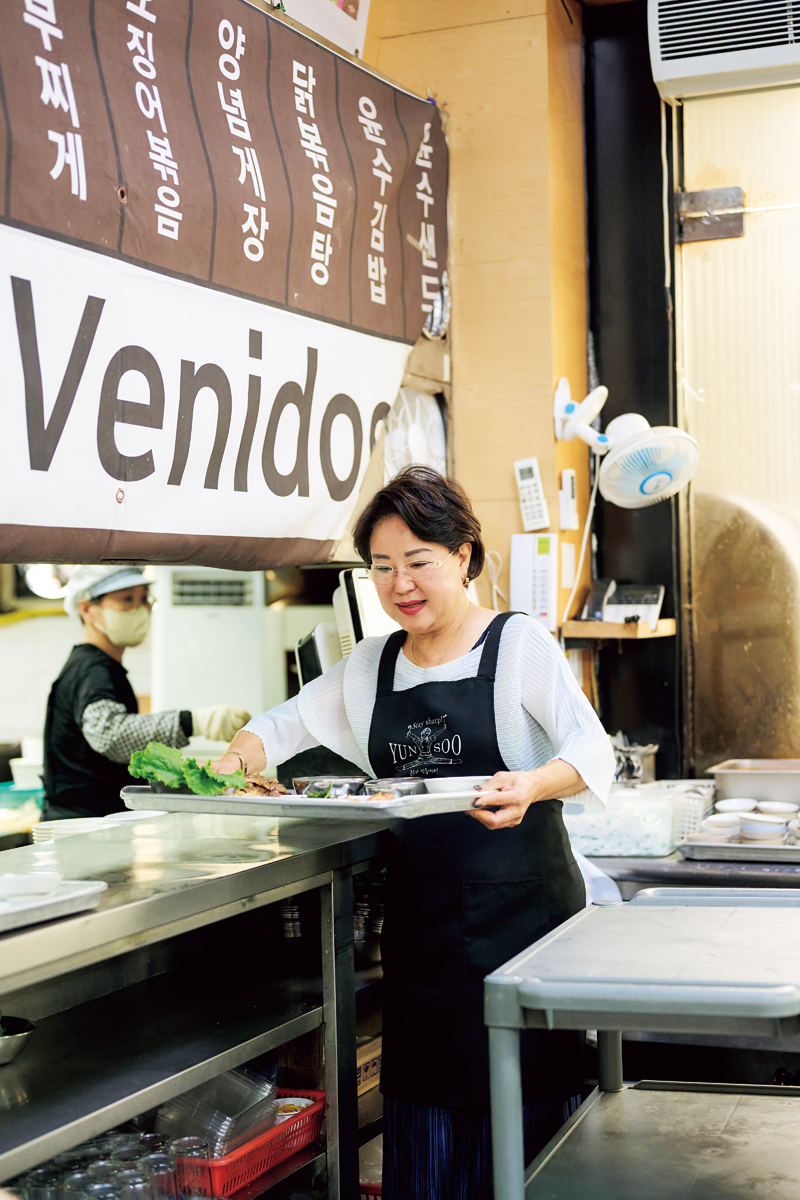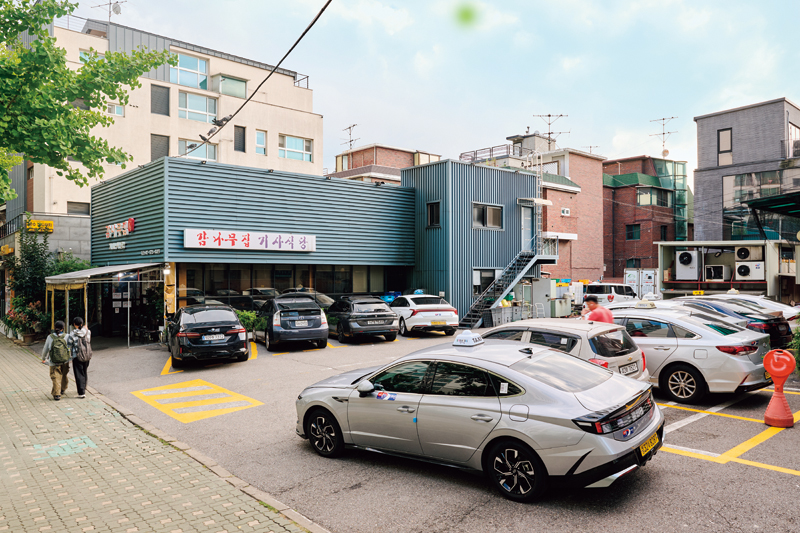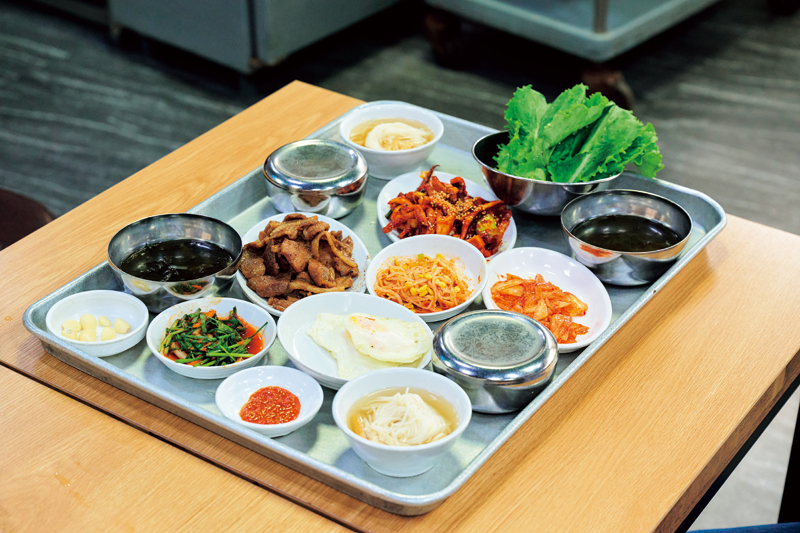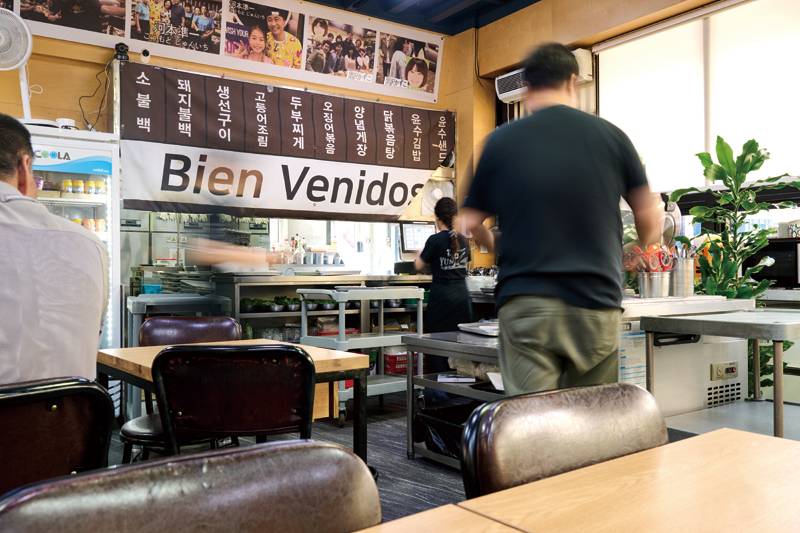Often, the surest way of finding a good place to eat when visiting an unfamiliar city is to ask a taxi driver. Thanks to their extensive knowledge of their respective localities, taxi drivers can pinpoint the best and most affordable restaurants, and since their suggestions are grounded in years of experience, they’re usually a safe bet. Busy around the clock, Gamnamujip Gisa Sikdang is a favorite among taxi drivers in Seoul.

Jang Yunsu, the owner of Gamnamujip Gisa Sikdang, carries a tray of freshly prepared dishes to her customers.
The term gisa sikdang refers to restaurants that specifically cater to taxi drivers. To meet their needs, such establishments must fulfill certain criteria, such as having ample parking space. While an extensive menu is an added bonus, they have to focus on dishes that can be served quickly. They should also be open early morning and late at night to accommodate taxi drivers who work around the clock. Finally, gisa sikdang should provide generous portions at affordable prices while ensuring the same great taste that regulars have come to expect over time.
NEVER CLOSED
For Jang Yunsu, owner of Gamnamujip Gisa Sikdang, located in Yeonnam-dong in Seoul’s Mapo District, every day begins differently.
“Some days I come in at dawn, but when I need to stop by the market, I get there a little later. My routine isn’t set in stone. Even when I go home to rest, I keep an eye on the restaurant through the video monitoring system. If I notice it’s busy, I drop everything and rush over,” she says.

Korea’s gisa sikdang, drivers’ eateries, must meet certain conditions, including convenient parking, generous portions, and a rapid table turnover to reduce waiting times.
Jang’s house is right next to the restaurant and its adjacent parking lot. Though this setup doesn’t provide a clear separation between work and personal life, she prefers it this way. “For anyone running a restaurant, living nearby is essential to stay on top of everything. If I’m needed, I can get there immediately. That’s what allows me to keep the business running 24/7.”
Although her restaurant can seat over seventy people, at lunchtime it quickly fills up. It has been open 24 hours a day, all year-round, for the past 25 years.
“I first ran a traditional Korean restaurant, and later a galbi [marinated beef short ribs] restaurant, but neither was successful. After going out of business, I came back to this house. This is our home. I initially set up a hamba [a makeshift restaurant near a construction site]. Because the workers started early, we opened at dawn. Gradually, taxi drivers began to stop in for a meal too. They said they would like us to stay open later, so I decided to keep the place running 24 hours,” Jang says. At her restaurant, taxi drivers can always count on a hot meal that is affordable and delicious, no matter the time of day. On top of this, the soups and side dishes change daily. Unsurprisingly, it didn’t take long for word to spread.
“There were many other gisa sikdang nearby, but they typically focused on just one dish, like sundaeguk [blood sausage soup] or seolleongtang [ox bone soup]. That’s why I decided to open a place that serves home-style food with a variety of side dishes. At the time, many drivers were struggling financially, and their wives worked too, so they didn’t have the chance to eat at home. That’s something they missed. Eating out alone can be inconvenient and pricey. But here, they could enjoy familiar dishes like miyeokguk [seaweed soup], doenjangguk [fermented soybean paste soup], and kongnamulguk [bean sprout soup]. They liked having the sort of meal they would have at home.”
A TASTE OF HOME
Jang grew up in Chungcheong Province as the seventh of eight children in a large farming family. Their home was always bustling with farmhands and relatives. Her grandmother and mother, both talented cooks, spent much of their time in the kitchen, preparing meals, making kimchi, and seasoning vegetables for side dishes.
Recalling those days, Jang says, “Every day, I watched them prepare and season all sorts of food, and I loved it. When friends came over, we would go pick cabbages and cucumbers from the garden, slice them up, and season them. It’s too salty, it’s too bland, let’s add this, let’s add that… That’s how we played. We made our own broths and kneaded our own dough to make noodles. When the adults tasted our dishes and praised them, it made us so happy. Whenever my mom got angry at me for not studying, I would just run away. How could I focus on studying when I was having so much fun? That’s when I realized I wanted to become a cook and run my own food business. I wanted to spend my life doing what I love.”
Jang serves her customers the same dishes she used to make at home. She even makes her own doenjang, using soybeans grown in Gangwon Province.
“I experimented a lot to come up with dishes for taxi drivers that I could prepare quickly without compromising on flavor, and that would be affordable yet filling. That’s how I came up with our signature dish: dwaeji bulbaek.”

Two of Gamnamujip Gisa Sikdang’s most popular menu items are dwaeji bulbaek, pork bulgogi served with a variety of side dishes, and ojingeo bokkeum, spicy stir-fried squid.
Consisting of pork bulgogi served with rice and side dishes, dwaeji bulbaek is the restaurant’s bestseller. Along with a generous portion of meat, the meal comes with fresh lettuce leaves and napa cabbage in which to wrap the meat. It also includes three or four side dishes, along with a fried egg and a small bowl of janchi guksu, noodles served in a light broth. The restaurant has a large rice cooker full of freshly cooked rice, so diners can freely refill their bowls. Extra portions of all side dishes, including the noodles, are free of charge, and after the meal, diners can enjoy a free cup of vending machine coffee along with some sweet crackers. At the end of every year, Jang even gives the taxi drivers a small calendar that they can place in their cars.
“In the past, I would eyeball measurements while cooking, trusting my taste buds to guide me. But before my son started his military service, he decided to write down all my recipes. That means the taste of my food remains unchanged,” Jang says.
When asked about the recipes or daily sales figures, she insists they are “top secret.”
EVERY CUSTOMER IS FAMILY
In the past, most customers at Gamnamujip were taxi drivers, but nowadays the majority come from all walks of life. Restaurants offering home-style meals with a variety of side dishes are becoming more difficult to find these days, so young people who find it more economical to eat out and families with children are increasingly drawn to this spot. The number of tourists eager to try out traditional Korean home cooking is also on the rise.
Jang’s daily routine changes according to the flow of customers. She generally starts each day at dawn and often makes trips to the market before heading to the restaurant. During the hectic breakfast hours, she usually has no time to eat until the lunch rush finally eases at around 2 p.m. From 3 to 7 p.m., she takes some time to unwind, checking her phone and catching up on sleep.
Weekend evenings are the busiest, with customers streaming in nonstop until the early morning hours. Jang spends her time going back and forth between the kitchen and the dining area, ensuring customers have everything they need while refilling their side dishes. She notes which side dishes are most popular and adjusts the quantity she makes accordingly. It’s not until 10 p.m. that she finally gets a chance to sit down for a late dinner.

Once primarily sought out by taxi drivers, the restaurant now attracts a wider crowd, from customers craving the taste of home-style cooking to foreign tourists seeking authentic Korean comfort food. This keeps the business bustling around the clock.
On weekdays, Jang wraps up her day at 1 a.m., but on weekends, she often finishes as late as 3 or 4 a.m. Her husband helps with the shopping and manages the parking lot during busy periods. Their son, who has inherited his mother’s love for cooking, is also an essential part of the team. Jang employs over twenty staff, most of whom have been with her for more than ten years, working in shifts. In Korean, one of the words for family is sikgu, composed of the Chinese characters meaning “food” and “mouth.” Thus, family means “people who eat together.” Jang’s team are all like family, and so are her customers, who come to enjoy the home-style food.
What started as a menu with just three items — dwaeji bulbaek, sundubu jjigae (spicy soft tofu stew), and saengseon gui (grilled fish) — has now expanded to ten dishes. This growth reflects Jang’s dedication to pleasing her customers, who wanted more options.
“I have no regrets. I still love cooking, and seeing people enjoy the food I prepare brings me more joy than anything else. The people who come to eat here feel like family to me. I truly enjoy cooking for them. I don’t feel tired at all,” she says.
“One dwaeji bulbaek, please!” an impatient customer calls out upon entering the restaurant. This brings a smile to Jang’s face.